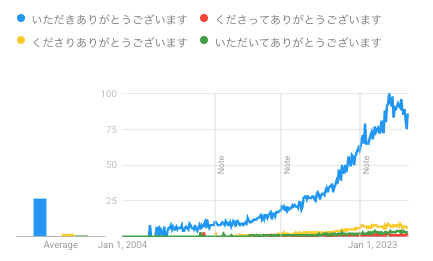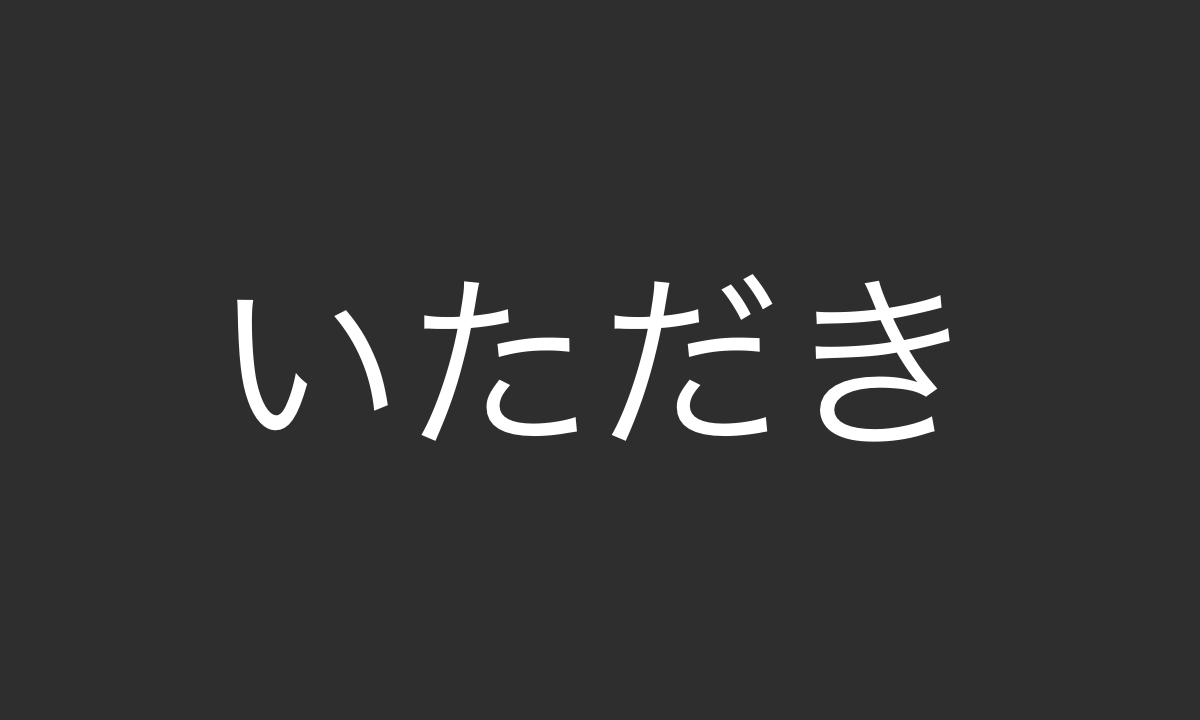This is How to Japanese, a monthly newsletter with something about Japan/Japanese and a dash of いろいろ.
日本・日本語:I wanna thank me
ください (kudasai) is one of the first few words that many students learn when studying Japanese. In Japanese: The Spoken Language, this is how Jorden and Noda define the word:
Kudásài is the imperative (command form) of the polite verbal of giving kudásaimàsu ‘give to me,’ or, more precisely, ‘[out-group] gives to in-group’. (93)
(Note that they use accents on the vowels to mark tone.)
Here are two pretty simple and straightforward examples of how ください and the verb くださる (kudasaru) work in context:
お冷ください (Ohiya kudasai, A glass of cold water, please)
Although this sent me down a long search about whether お冷 is a polite word or not. There are lots of opinions, so you might want to go with:
お水ください (Omizu kudasai, Water, please)
As we see, ください can be used to ask for a specific item.
It can also be combined with the て form of a verb to express the receiving of some action from another person:
教えてください (Oshiete kudasai, Please tell me)
This essentially means “give me the teaching of (something).” In other words, “tell me something.” Take this tweet, for example, which is seeking recommendations for a tofu pudding shop in Yokohama:

ください is a useful word, but I do think learning it so early on can hamstring many students whose native languages don’t have such flexible giving-receiving verb matrices. I think what ください does, essentially, is overemphasize to new students the utility of the verb くださる, which is arguably the least useful of all four giving-receiving verbs.
To review, we have:
くださる (kudasaru) - someone gives to person (polite)
くれる (kureru) - someone gives to person (neutral)
いただく (itadaku) - person receives from someone (polite)
もらう (morau) - person receives from someone (neutral)
I’ve simplified this because trying to get overly precise with it (as I think Japanese: The Spoken Language does at times) can cause more confusion. I’ve intentionally left out all the verbs of giving—あげる (ageru, give to someone - neutral) and さしあげる (sashiageru, give to someone - polite)—because the point I’d like to make has to do with receiving, and I’ve tried my damndest to find the most general way to refer to the parties involved. “Person” here is the central character, often the “I,” “me,” “we,” or “us” in the sentence, and “someone” is generally in third person or second person. The "you," "he," "she," or "they" in the sentence.
These are the verbs used to construct sentences like “He gave me the game”/“Your company gave us the materials” or “I received the game from him”/“We received the materials you all provided.”
A quick, very unscientific count of Google results at the time of writing does seem to back up my sense that くださる is the least useful:
買ってくれた - 25.3 million
買っていただきました - 21.5 million
買ってくれました - 18.2 million
買ってもらった - 17.8 million
買ってもらいました - 15.8 million
買っていただいた - 9.02 million
買ってくださった 5.95 million
買ってくださいました - 2.42 million
I’ve included both the distal (くださいました) and direct (くださった) version of the verbs to be completionist, and both versions of くださる are at the bottom of the list.
While this is a nice little party trick, it’s also important to consider when and in what circumstances people (especially students) are trying to use these words. Other than the imperative form of ください when someone is asking for something or asking someone to do something, I think くださる gets used in one of two situations:
1. Trying to explain how something was acquired or who did something (for someone).
2. Trying to thank someone.
Today I’d like to look closely at the second here because I have a phrase that I think will help reorient you in a more Japanese space.
The main shift is from the very English-oriented “thank you for doing X” to a more Japanese “thank you for me receiving X.” If you need a mnemonic to help you remember this shift, please channel the Snoop Dogg meme “I wanna thank me”:
@tpain I wanna thank me 😎 @snoopdogg @nappyboyradiopodcast #nbrp #snoopdogg
♬ original sound - T-Pain
What this does is shift us from a phrase that is perfectly fine Japanese but oriented around the action of the giver (3.3 million hits on Google):
教えてくださってありがとうございます。(Oshiete kudasatte arigatō gozaimasu, Thank you for telling me that)
To a phrase that is also perfectly fine Japanese but oriented around the receiver of the action (15.3 million hits on Google—FIVE TIMES more frequently used):
教えていただきありがとうございます。(Oshiete itadaki arigatō gozaimasu, Thank you for me receiving that telling from you)
Why did I use いただき instead of いただいて? I don’t know, to be honest. It just felt more natural. It’s what you hear working in a Japanese office. A search for the same phrase with いただいて gives 2.2 million results on Google, and vice versa searching for くださり gives 3.1 million results, just behind くださって. So there’s a bizarre flip here where the て form of くださる appears to be slightly more natural/widely used but the stem of いただく is much more natural/widely used.
For further confirmation, check out this Google Trends search which shows いただきありがとうございます way ahead of the alternatives. It also suggests this phrase has seen significant growth in the past 20 years:

Once you master a few phrases, you’ll be using this in no time. Here are a few helpful examples:
ご共有いただきありがとうございます (Go-kyōyū itadaki arigatō gozaimasu, Thank you for sharing [insert contextual shared item] with us)
ご説明いただきありがとうございます (Go-setsumei itadaki arigatō gozaimasu, Thank you for the explanation)
お越しいただきありがとうございます (O-koshi itadaki arigatō gozaimasu, Thank you for coming)
お問い合わせいただきありがとうございます (O-toiawase itadaki arigatō gozaimasu, Thank you for your inquiry)
ご紹介いただきありがとうございます (Go-shōkai itadaki arigatō gozaimasu, Thank you for the introduction/for introducing me to something)
I imagine that many readers have heard these phrases already, and if you haven’t, now that I’ve pointed them out, you’ll start to notice them everywhere. The next step is to incorporate いただき into your active Japanese vocabulary.
Note that I have provided normal English translations of these phrases rather than intentionally stilted translations to highlight how the grammar is working. In effect, the sentences mean the same thing regardless of whether you use くださって or いただき. Japanese, very conveniently, just has two different ways of saying thank you.
いろいろ
- IMPORTANT NOTICE: There is still space left in the USJETAA Japanese Coaching sessions on October 10 (US)/11 (Japan). If you feel stuck in your studies and want help with strategies to get to the next level, come hang out. Register online here.
- The podcast is out over on the blog, where I dig into various forms of receiving via a Yahoo Chiebukuro article.
- Speaking of the blog, I've quietly been posting away during Murakami Fest 2025. This year, I'm continuing my look at Distant Drums, Murakami's memoir of living in Europe for three years while he wrote Norwegian Wood and Dance Dance Dance.
- I basically agree with this Silksong review. Hell of a game, but one that I'll likely DNF.
- If I was still teaching, I'd absolutely be using the strategy posted by this professor.
- I was not aware of the competitive kendama scene.
@juggle_guy Attempting to get my #1 spot in the world back on Kendamanomics… WATCH TILL THE END!! #kendama #fyp #skill #kendamanomics
♬ original sound - Caseyh
- Fascinating article about a Japanese soldier who ended up staying in the USSR after World War II and turned up in Ukraine in 2005 after being declared dead in 2002. Discovered via AJATT.

Member discussion: